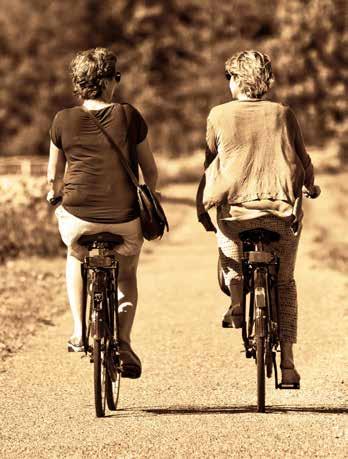
4 minute read
Exercise before menopause is important to optimize health in later years
The small blood vessels in muscles of women after menopause are less able to grow compared to young women, according to new research published today in The Journal of Physiology. This means exercising before menopause is all the more important for women in order to develop blood vessels in muscles, and thus the ability to develop muscle strength.
Recent studies have shown that there are some substantial differences in the way the blood vessels, which influences susceptibility to conditions like heart disease and stroke, are affected by aging and physical activity between women and men, a difference which to a large extent is related to the female sex-hormone, estrogen.
Advertisement
Estrogen is protective of the heart and blood vessels in women for about half of their lives, but, at menopause, there is an abrupt permanent loss of estrogen, leading to a decline in the health of our blood vessels.
In this study, the researchers at the University of Copenhagen examined the smallest of blood vessels in muscle, called capillaries. The number of capillaries in skeletal muscle can change a lot and is mainly affected by how much the muscle is used, such as during exercise. This is the first study to isolate and examine cells from skeletal muscle samples of young and old women. Capillaries in skeletal muscle (as opposed to heart muscle) are very important for skeletal muscle function, physical capacity and health as it is here that oxygen and nutrients, such as sugar and fats, are taken up into muscle when needed. It is known that loss of capillaries in muscle can affect insulin sensitivity and thereby the development of Type II diabetes. The study also found that, when the aged women completed a period of aerobic exercise training by cycling, they did not achieve an increase in the number of capillaries in muscle, in contrast to what has been repeatedly shown in young and older men.
Aging is known to lead to a loss of capillaries in the muscle, an effect which, in men, has been shown to be counteracted by a physically active lifestyle. This new study suggests that women do not attain capillary growth as readily and that an underlying cause may be a flaw in the cells that make up capillaries.
It is important to underline that both men and women have a vast benefit from being physically active throughout life, regardless of age, but the current study supports the idea that women may benefit from being physically active before menopause, while they still have estrogen, so that they have a good physical starting point as they get older.
The researchers studied older women (over 60 years old) and young (around 25 years old) ones. The women underwent a series of physical tests, and the researchers obtained small samples from their thigh muscles.
The muscle biopsies were used to isolate blood vessel cells and muscle cells for further detailed study in the lab. The
older women then also conducted 8 weeks of cycling training, where they trained three times per week at moderate to high intensity.
The women were tested for fitness and several other parameters before and after the training. After the training period samples were again obtained from the thigh muscle and used for analysis of capillary number and specific proteins.
Line Nørregaard Olsen, first author on the study said:
“Another aspect that is worth highlighting is that many people doubted that the older women could handle such intensive training. However, the women, who conducted the cycle exercise training (spinning training) 3 times per week for 8 weeks, with heart rates over 80% of maximal heart rate for more than 60% of the time, were excited and handled the training without problems. This underlines that the popular view of how hard women of that age can train should be revised.”

Link to paper https://physoc.onlinelibrary.wiley.com/doi/abs/10.1113/JP280189 The Journal of Physiology publishes advances in physiology which increase our understanding of how our bodies function in health and disease. http://jp.physoc.org The Physiological Society brings together over 4,000 scientists from over 60 countries. The Society promotes physiology with the public and parliament alike. It supports physiologists by organising world-class conferences and offering grants for research and also publishes the latest developments in the field in its three leading scientific journals, The Journal of Physiology, Experimental Physiology and Physiological Reports. www.physoc.org
est Ridge obstetrics & gynecology, LLP
3101 West Ridge Road, Rochester, NY 14626 Tel. (585) 225-1580 Fax (585) 225-2040
www.wrog.org
1682 Empire Boulevard, Webster, NY 14580 Tel. (585) 671-6790 Fax (585) 671-1931









